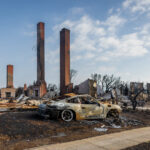Wisconsin regulators are following up on thousands of old chemical spills where cleanup consultants may have skipped a key step – investigating whether toxic vapors could seep into nearby homes or businesses.
The state Department of Natural Resources says a “noticeable” string of site owners applied to have their cleanup cases officially closed, even though they hadn’t checked for vapor leaks as required. No one at the agency knew precisely how many sites failed to investigate the potential for fumes build-up, so the DNR sent notices to all 2,500 sites in September clarifying that the vapor tests were mandatory.
“In 2010, we published our final guidance for the state, so we’re into 2011 and people are telling us, ‘Oh, nobody ever told us,”‘ said Terry Evanson, the director of the DNR’s vapor-intrusion program. “We were getting tired of listening to that excuse, so we sent a letter to every site in the whole state.”
A review by Gannett Wisconsin Media found that many site owners have only recently begun the tests. Hundreds of other sites may never be checked unless the owners do new construction or sell their properties.
None of the Wisconsin incidents of fume buildup has risen to the level of being added to a federal database. Still, even the possibility that harmful fumes could contaminate a home can be devastating for owners.
Deanna Schneider bought her home on Madison’s east side in 1997. The Madison-Kipp Corp. factory, which makes aluminum-based components, is located just behind her house, but Schneider figured she could tolerate the proximity because she liked the neighborhood.
Last year, the company and the DNR notified her and two neighbors that chemicals might be seeping into their basements as vapor. Schneider, a single mom of a 9-year-old son, felt blindsided.
“`I was really angry,” she said. “I was shocked. I was very disheartened with the fact that they had been telling me everything was OK.”
Madison-Kipp tested the soil beneath her basement and found 1,080 parts per billion of tetrachloroethylene in the clay, far higher than the 6 parts per billion that requires a mitigation system be installed.
The DNR forced the company to pay for a mitigation system, but Schneider said she’s still worried about all the children on the block who have been exposed to the chemical since the day they were born.
Investigating vapor intrusion is intended to guard against a future problem as buildings’ foundations develop cracks for chemical vapors to get inside and collect at harmful levels. Evanson said regulators were less concerned with small one-time spills than with long-standing industrial sites and other businesses that used chemicals daily.
Those cleanups can take years, and many site owners are dependent on consultants to follow DNR rules.
Ken Lassa, an environmental department manager for Wausau-based REI Engineering, said the site-cleanup industry has been aware of vapor intrusion for at least 20 years, but the competition for jobs will lead some firms to take shortcuts.
However, even when consultants or site owners properly investigate vapor intrusion, the DNR only closes the cases with the caveat that new construction could require more testing.
For example, at the former home of Kerwin Paper Co. in Appleton, tests found levels of toxic chemicals in groundwater at the site. Now the site of an apartment complex, developers and the DNR designed a ventilation system to prevent vapors from causing health issues.
Was this article valuable?
Here are more articles you may enjoy.

 BYD’s Five-Minute Charges Turning Heads in EV Industry
BYD’s Five-Minute Charges Turning Heads in EV Industry  Wall Street Brokers Start Trading Insurer Claims From LA Fires
Wall Street Brokers Start Trading Insurer Claims From LA Fires  California Man Wins $50M in Lawsuit Over Burns From Starbucks Tea
California Man Wins $50M in Lawsuit Over Burns From Starbucks Tea  Peeling Back the Value: Why Art Is Worth More Than Meets the Eye
Peeling Back the Value: Why Art Is Worth More Than Meets the Eye 